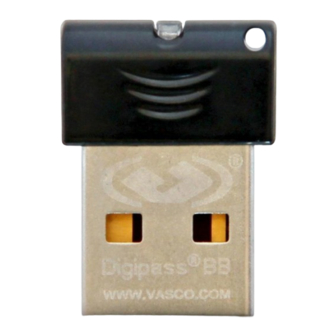Advertisement
Advertisement
Table of Contents

Subscribe to Our Youtube Channel
Summary of Contents for Vasco DIGIPASS
-
Page 1: User Manual
® DIGIPASS Bluetooth Bridge FCC ID: 2AH88-DPBB User manual... - Page 2 BLUETOOTH BRIDGE For PCs that do not support BLE, VASCO offers our DIGIPASS ® Bluetooth Bridge in a USB dongle. When you insert the dongle into the USB port of a computer, (effectively pairing the DIGIPASS ® SecureClick with the DIGIPASS ®...
- Page 3 ® SecureClick is still active, then the DIGIPASS ® Bluetooth Bridge will blink green. o If the DIGIPASS SecureClick is not active anymore, then the DIGIPASS ® ® Bluetooth Bridge will stop blinking. Now the DIGIPASS ® Bluetooth Bridge is ready to use.
- Page 4 When you have added the application to your chrome applications, open it. Select “Add SecureClick” and follow the on screen instructions. o Long press SecureClick, indicates that you have to press the DIGIPASS ® SecureClick button for at least three seconds, it successively turns full red and running blue.
- Page 5 When this is complete it will turn off. When the DIGIPASS ® SecureClick is turned on by a short press, the DIGIPASS ® Bluetooth Bridge will first briefly flash yellow, this means it is checking driver installation. Then it will flash green, which means it has found a DIGIPASS ®...
- Page 6 Technical information you can find at the FCC website with the FCC ID: 2AH88-225. https://fccid.io/2AH88-225 FCC STATEMENTS This device complies with part 15 of the FCC Rules. Operation is subject to the following two conditions: (1) This device may not cause harmful interference, and (2) this device must accept any interference received, including interference that may cause undesired operation.




Need help?
Do you have a question about the DIGIPASS and is the answer not in the manual?
Questions and answers
can i buy a charging cable for a digipass dp302cv